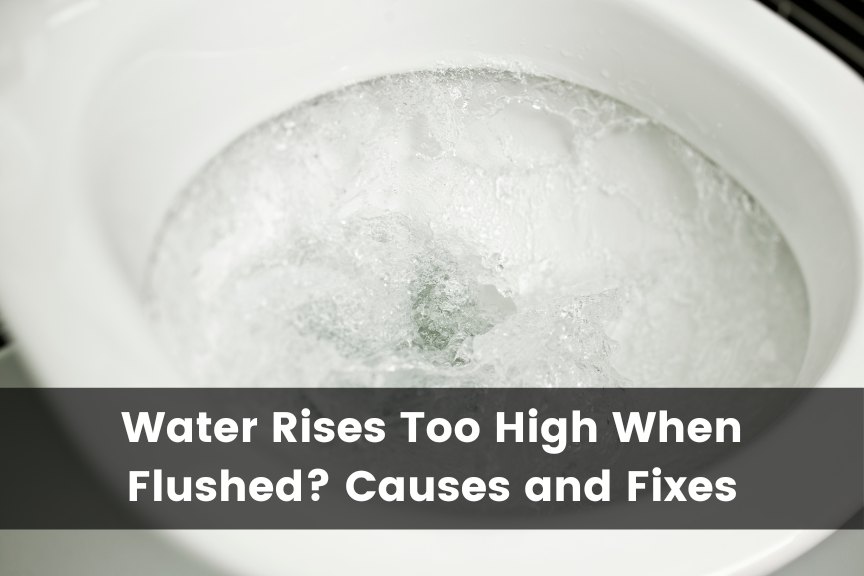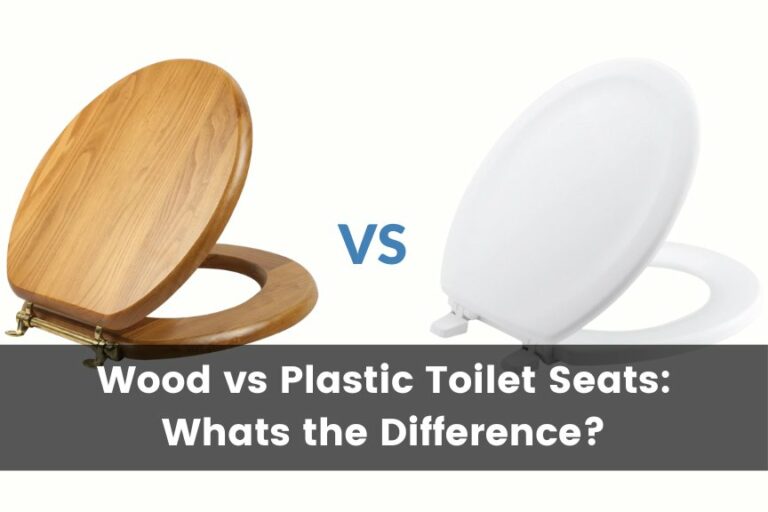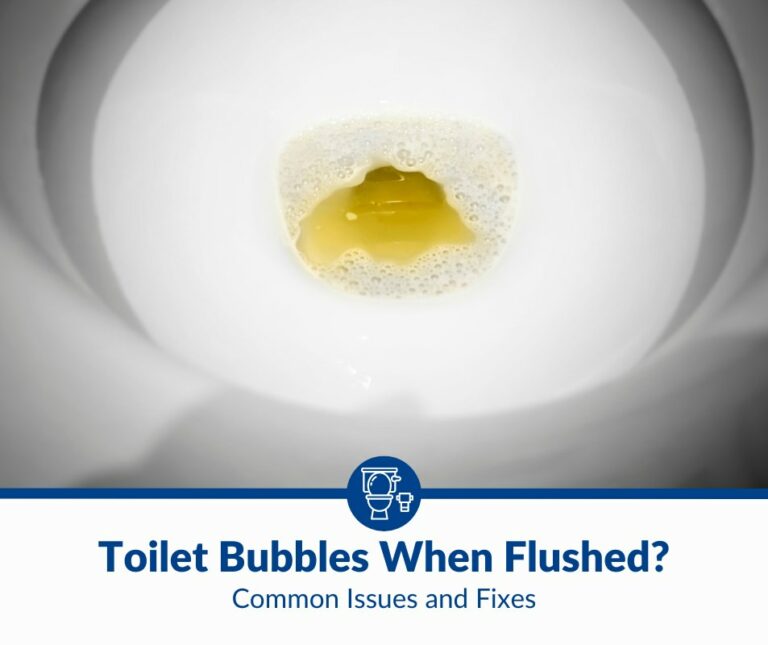Toilet Won’t Flush? Water Rises Too High When Flushed Fixes
Flushing your toilet shouldn’t be a stressful experience, but when the water starts rising when it’s supposed to go down, you may panic! Luckily, the cause is usually benign and is often easy to fix before it turns into a mess.
Your toilet won’t flush because the pipe or air vent is clogged or the toilet flapper is faulty. You can usually fix these issues by using a plunger, a plumber’s snake, or replacing the flapper.
In this article, I’ll explain in detail the possible reasons why the water in your toilet starts to rise after you flush it. I’ll also explain how to fix the problem so you can get back to stress-free flushing. Let’s get started!
Why Your Toilet Isn’t Flushing
To fix a toilet that isn’t flushing the way it should, you first need to diagnose and understand the cause. For first-time homeowners or non-plumbers, this may be easier said than done.
Let’s look at the reasons why the water in your toilet might start to rise after you flush it:
The Pipe Is Blocked
One of the most common reasons water will start to rise after you flush the toilet is if there is a blockage in the pipe.
When you flush a toilet, water rushes into the bowl and empties the tank. The water pressure forces the water to go into a trapway. The water creates suction over the top of the trapway, eventually forcing the water and waste away through drains and pipes. The waste continues into the sewerage pipes, which eventually lead to the sewage treatment processing center.
However, if there is a blockage in the pipes, the waste won’t make it to the sewage processing center and will instead gather in the pipes, eventually becoming so entangled and large that nothing can pass through. As a result, when you flush the toilet, the water won’t quickly drain away, and may rise in the toilet.
If your toilet pipes are blocked, you may also notice gurgling sounds or an intense foul odor.
However, some toilets are more prone to blocking than others. Examples include:
- Old pipes
- Corroded or damaged pipes
- Low-flush toilets that don’t provide enough pressure to move the waste as much and as quickly as needed
- Your toilet water has high mineral content, which can damage pipes
However, there are many things you may be doing that put you at risk for more toilet pipe blockages and problems. The main problem many people face is using too much toilet paper.
Here are some suggestions to avoid blocking your pipe with toilet paper:
- Flush your waste and flush again for toilet paper.
- Don’t crumble the toilet paper. Folding it makes it easier to go down the drain.
- Use high-quality toilet paper, so you don’t have to use as much to feel clean. I suggest the Betterway Bamboo 3-Ply Toilet Paper from Amazon.com because it is soft, and each sheet has three layers of premium toilet paper with two sides and a textured side for easier grip, which means you’ll get better wipes every time and end up using far less toilet paper. I also like how eco-friendly the paper is.
- Forego toilet paper entirely and get a bidet.
Another common reason for blocked pipes is that people flush things down the toilet that they shouldn’t. Here are examples of items that you should never flush:
- Female hygiene products
- Diapers
- Makeup wipes
- Cotton balls
- Antibacterial wipes
- Cotton swabs
- Dental floss
- Food
- Paper towels
- Baby wipes (even the “flushable” ones can cause damage, so avoid flushing any kind of baby wipe)
- Condoms
- Tissues
- Medicine
- Hair (such as loose hair pulled from a hairbrush)
Finally, a common cause of drain and pipe blockage is people accidentally flushing something they dropped in the toilet, such as a child flushing a toy or someone flushing a toothbrush or razor blade that fell in. If you notice something in the toilet that shouldn’t be there, remove it instead of flushing it.
The Air Vent is Clogged
Another possible cause of water rising after you flush is that the air vent in your plumbing system is clogged and not working as it should.
The plumbing system needs air to work properly and allow the water to flow, so the water will gather where it is and eventually start to rise out of the bowl. The main air source in your plumbing system is the plumbing vent.
If this is the cause of your toilet water rising after you flush, you’ll notice the problem in all of your toilets, not just one, because the air vent affects the entire plumbing system. Other signs of a problem with the air vent include:
- A strong and foul odor
- Slow toilet water drainage
- Gurgling sounds when you flush
When you flush a toilet, the water passes through the pipes and creates a vacuum. At this point, the plumbing vent provides air to push the water through the piping. This air also removes any gasses or smells the wastewater might cause.
It isn’t unusual for plumbing air vents to become clogged because they are usually located outside and exposed to the elements, such as leaves and other debris.
The Toilet Flapper Isn’t Working
The flapper is essential to your toilet, even though you may not think about it very often. The flapper is the piece of rubber that sits in your toilet tank and is responsible for opening and closing the drain.
When the flapper is broken or worn out, it stops doing its job effectively and may not close after every flush. In this case, a large quantity of water will enter the toilet bowl, causing it to rise too high when flushing.
Not only that, it will cause your water bill to go up a lot, which is not ideal for your budget or the environment.
The problem may be with the chain or the flapper itself. Often, the chain isn’t long enough to close the flapper completely. In other cases, the chain might be kinked or bent, making it shorter and less effective.
Another possible issue is a buildup of debris or gunk on the flapper seal. You can quickly solve this issue by cleaning the flapper with a sponge or an antibacterial wipe. If you decide to use a reusable cleaning tool, don’t use it to clean anything but your toilet, as the bacteria can easily transfer to other surfaces.
4 Easy Fixes for a Malfunctioning Toilet
After you’ve determined why your toilet isn’t flushing the way it should, it’s time to fix the problem.
Here are some things you can do to get your porcelain throne back in prime working condition:
1. Fix the Blocked Pipe
The first step of fixing a blocked pipe is to remove the clog with a plunger. If you don’t already have a plunger, I recommend investing in this necessary household item and keeping it somewhere in your most highly-trafficked bathroom. It’s much better to have it when you need it than not when the water rises after a flush.
You can buy a good quality plunger from hardware, a big box, or a grocery store. Most plungers are hardy, universal, and will last for years.
Plungers create pressure and force water to go down the toilet and then suck it back up, which pushes and pulls on the clog and, hopefully, eventually dislodges it.
To use a plunger effectively, follow these steps:
- Place the rubber lip on the plunger around the toilet hole, creating a seal.
- Hold the plunger handle so the plunger is straight up.
- Put both hands on the handle.
- Push the plunger in and out for ten to twenty seconds. Don’t break the seal over the hole.
- Lift the plunger and allow the water to drain.
- Try again if your first attempt was unsuccessful.
- If you see any visible debris, try removing it instead of flushing it again.
You can also try flushing a mixture of hot water and dish soap down the toilet, which can be enough to loosen a clog and fix it. Another mixture that works well is baking soda and vinegar. You could also consider a drain clog dissolver.
Bear in mind that drain dissolvers and cleaners have harsh ingredients, so it’s important not to get any product on your hands or accidentally spill any.
I like the Green Gobbler Liquid Drain Clog Remover and Cleaner from Amazon.com because it is safe to use in the toilet and quickly dissolves hair, soap, toilet paper, and flushable wipes. I also like that the dual-chamber bottle has two pre-measured applications, so it is easy to measure and has less risk of using too much or too little of the product. This product doesn’t include any bleach or sodium hydroxide, which can be damaging to pipes.
You can also try using your hands to clear the drain yourself. This is not a pleasant task but can be effective. To do this, put on a pair of thick rubber gloves and push your hands down the toilet until you feel what is blocking the drain. Then, you can pull out whatever is causing the clog.
Another useful tool you could use is a toilet auger like this Gulrear Store Toilet Auger Grabber Tool from Amazon. I like this grabber because it easily picks up items, and the 69-inch length is long enough to reach far into the toilet to grab even deeply-lodged clogs. The grabber has a thickened, non-slip plastic handle that is easy to hold and won’t rust.
To use this tool, insert it into the toilet bowl and rotate the handle down the pipe until the water goes down.
2. Unclog the Pumbling Vent
If you are uncomfortable climbing on top of your roof, I suggest calling a professional to get assistance. However, if you do feel okay with doing some work on your roof, follow these steps:
- Climb onto your roof.
- Hold your hand over your plumbing vent and have someone in the house flush one of the toilets to check if this is the issue. If you feel suction, the air vent isn’t the reason for your problems.
- Insert a plumber’s snake into the vent. This should unclog the pipe.
- Once you’ve removed the debris, have someone flush a toilet again to see if you feel any suction from the vent. If you do, you’ve likely fixed the issue.
- If the plumber’s snake didn’t work, try spraying a hose into the pipe.
I like this MEISTERFAKTUR Drain Snake from Amazon because it comes with a video tutorial that demonstrates how to use it, and the drill attachment on the drain minimizes the amount of manual cranking you’ll need to do and, therefore, how much energy you’ll expel working on clearing the clog. I also like that the snake is made from recycled ABS material, making it more eco-friendly.
Air vents often get clogged because of natural elements outside your control. However, there are some things you can do to try and prevent future clogs. Here are my suggestions:
- Keep your trees trimmed. Trimming back any trees that hang over your roof is a good way to prevent clogging. One of the most common causes of an air vent blockage is leaves, especially wet ones, so anything you can do to minimize the number of leaves getting on your roof is beneficial.
- Reconsider a vent cap. You may think getting a vent cap is the best way to keep out any animals or debris, but if you live in a cold climate, the cap can create an ice barrier that blocks air from getting through. In warmer climates, a vent cap isn’t usually a problem.
- Keep an eye out for nests or other signs of animals. One of the most alarming causes of a blocked air vent is animals getting inside and building nests or getting stuck. Try to keep an eye out for animals and do what you can to keep them away from the area. Of course, safety is of utmost importance, and I don’t recommend touching any animals or nests you encounter.
A clogged plumbing vent is usually an easy and quick fix, especially if you get the help of a professional. However, if you avoid addressing the clog, your toilets won’t flush correctly, and the water will start to rise.
3. Replace the Faulty Flapper
If you think your flapper is the cause of your toilet not flushing properly and you don’t notice any problems with the chain, it may just be time to replace the flapper completely.
Luckily, you can easily do this yourself without the help of a plumber. Here’s how:
- Put on a pair of rubber gloves.
- Turn off the toilet water by twisting the shutoff valve clockwise.
- Flush the toilet to change the tank. If not all the water drains, hold the handle down until the water completely drains.
- Locate the flush handle lever. It is the horizontal bar located just above the flapper.
- Disconnect the chain from the lever by undoing the clip.
- Cut off the ring on the back of your new flapper. Not all new flappers have a ring on the back, but most do.
- Put your new flapper in place.
- Hook the flapper into the pegs of the flush valve.
- Reconnect the flapper chain to the lever.
- Check to ensure the chain isn’t too tight or too loose.
- Turn the shutoff valve counterclockwise to switch the water back on.
- Flush the toilet to see if the flapper works as it should. If the flapper is working, the water should go all the way down and stop running quickly.
I suggest using a pair of thick rubber gloves while you do this to avoid getting your hands wet and contaminated with toilet water.
With a new flapper in your toilet, you shouldn’t experience more problems with flushing. Even if you aren’t having problems flushing your toilet, it is a good idea to replace your flapper somewhat regularly to avoid having issues in the first place. You should replace your toilet flappers at least every four to five years.
4. Call a Plumber
If you have tried all of the above fixes, and nothing has worked, it’s time to call a plumber. There may be a broken or worn-out part somewhere in your toilet’s system that you haven’t noticed or an issue with another cistern part.
A plumber will usually quickly identify and resolve the problem. If you don’t have a reliable plumber, ask your neighbors, friends, or family for a recommendation, or check a local plumber’s reviews online.
Final Thoughts
There’s no worse feeling than flushing your toilet only to see the water going up instead of down. In some cases, this problem could signify a serious plumbing issue. However, it is more likely that it is a blocked pipe, a clogged air vent, or a broken or old flapper. If it is one of these issues, you can likely fix the problem yourself.
If not, call a plumber to fix the issue.







